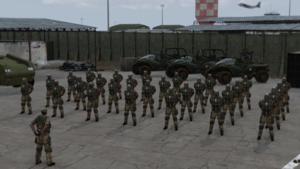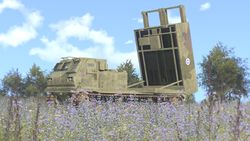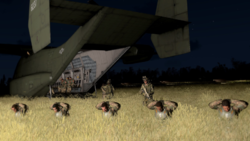Seven-Day War
| Seven-Day War | ||||||||
|---|---|---|---|---|---|---|---|---|
| Part of the Northern Conflicts | ||||||||
 Seabersian paratroopers prepare to embark on Operation Archangel. |
||||||||
|
||||||||
| Combatants | ||||||||
Freivia Neustuhl Supported by: |
||||||||
| Commanders and leaders | ||||||||
Amelia Ralston |
||||||||
| Strength | ||||||||
| 90,000 troops 800 tanks 1,500 combat aircraft | 210,000 troops 1,200 tanks 750 combat aircraft | 320,000 troops 1,350 tanks 650 combat aircraft |
||||||
| Casualties and losses | ||||||||
| 257 killed 1,254 wounded 12 captured 25 tanks destroyed | 8,471 killed 16,521 wounded 5,000 captured 284 tanks destroyed | 25,963 killed over 20,000 wounded 40,000 captured 432 tanks destroyed |
||||||
The Seven-Day War (Platacian: Kystkrig, "Kysten War"; Seabersian: Östkriget, "Eastern War"), also known as the Northern War, Kysten War, Kyrsten War, or Weeklong War was fought between March 2 and 9, 2027, by the Northern Alliance, Platacia, Ironcastle and several other nations.
Relations between Seabersia and Platacia had not recovered since the Seabersian Civil War. In 2026, Platacia invaded the Kysten region of Seabersia, its stated goal as being the reclamation of territory lost in the collapse of the Second Empire. In response, Ironcastle held negotiations between Platacia and the victors of the Seabersian Civil War, led by Verard Duttler. The treaty removed both Platacian and Seabersian troops from the territory and created an autonomous government under Ironcastle, protected by Ironian peacekeepers.
Tensions had been rising between Seabersia and Platacia for several months prior to the war. On the 28th of February, 2027, nine Seabersian nationals killed two dozen Platacians in the city of Gravida. Platacia blamed the Seabersian government, calling it "an act of war", and moved troops into Kysten. In response, Seabersia invoked Article 15 of the Northern Alliance Charter, declaring war on Platacia with its alliance. During this, several Ironian outposts in Kysten came under attack as well. As such, Ironcastle declared war on Seabersia (and by extension, the entire Northern Alliance).
The initial Seabersian advance was swift, pushing Platacian troops out of Kysten entirely. On the Ironian border, Freivia launched the largest airborne assault since the Second Great War in Operation Archangel. However, entrenched Ironian defenders and a lack of Freivian air supremacy quickly turned the assault into one of the largest disasters in military history. Over ninety percent of the attacking force was killed or captured, more than thirty thousand men in total.
Following Operation Archangel, Ironian and Platacian forces began pressing into Northern Alliance territory. Operation Steel Dawn saw Ironian troops move sixty kilometres into Freivia in twenty-four hours. Following significant gains by Ironian forces, Ironcastle called for a ceasefire.
The Aelcrest Peace Accords saw Kysten officially transferred to Platacia in perpetuity, with Seabersia renouncing all claims on the territory. In addition, Seabersia and Freivia were forced to pay hundreds of billions of dollars in reparations to both Ironcastle and Platacia. As a result of the war, Freivia became involved in a six-month long civil war soon after, one that resulted in the collapse of the Ralston regime.
Background
The war was part of the Northern Conflicts, a series of wars, interventions and skirmishes between Platacia and Seabersia which ended in late 2028. During the Seabersian Civil War of 2024-2026, Platacia had invaded the region of Seabersia known as Kysten (Kyrsten in Seabersia), fighting both the government and rebels. However, after the defeat of the Vazir government in Seabersia, the new government led by Verard Duttler agreed to sit down with Platacia in Aelcrest to negotiate over the status of Kysten. After several days of negotiations mediated by Ironcastle, it was agreed that Kysten would become an autonomous demilitarised zone administered by Ironcastle. While neither side was pleased with the outcome, both Platacia and Seabersia accepted it nonetheless.
Soon after the end of the Seabersian Civil War, Platacia became involved in the War of Honour against the Youthsville Pact. Its navy lost several ships in the fighting, but the nation was unscathed. Platacia's performance in the war had emboldened its military, and increased its favour with the Emperor. Polls showed that public opinion of the parliament led by Prime Minister Vikoren enjoyed widespread support.
By comparison, Seabersia had less success since the end of its civil war. Despite investment from outside sources, its economy was struggling. Militia groups were still being integrated into the national military, which itself utilised a mixture of foreign-supplied weaponry and equipment developed by the Vazir government. Following the loss of the Kysten region during the civil war, there were demands that the Duttler government send forces into the demilitarised region. However, these demands were initially rebuked, with the President refusing to draw Ironcastle into a war.
Three weeks before the war began, Seabersian intelligence services both covertly and publicly assassinated several prominent Ironian citizens within the country. Despite the insistence by the Seabersian government that the Ironian nationals were spies, several nations including Ironcastle, Platacia, Banana Federation and Scuro placed sanctions on Seabersia in response. Many within the Ironian Congress called for war in retaliation.
On the 28th of February, nine Seabersian nationals, part of the terrorist organisation "Valkyrie", attacked Gravida. During the several-hour long engagement with Platacian police and paramilitary units, 89 Platacians were killed, in addition to all nine terrorists. Before the attack had ended, Platacian Emperor Espodito Siciliano went on television and blamed the incident directly on the Seabersian government. Several other governments across Moneylania shared the view, including every member of MATO and several members of the Youthsville Pact. Despite the protests of the Seabersian government, sanctions were applied by the accusing states, and several nations issued travel bans.
Immediately following the terrorist attack, Northern Alliance, Platacian and Ironian forces had begun moving toward their respective borders. The Youthsville Pact offered to mediate negotiations between Platacia and Seabersia, but both sides refused. At 10:05 p.m. the 1st of March, Platacian forces began moving into Kysten. The small Ironian garrison in the region offered no resistance to Platacian forces. Several accounts indicate that some Ironian soldiers assisted Platacians in dismantling roadblocks and fortifications. Two hours after the Platacian incursion into Kysten, a multitude of anti-Platacian and -Ironian videos were posted on the internet, allegedly showing human rights violations by the respective governments. Five hours after that, at 5:00 a.m. on the 2nd of March, Seabersian forces began shelling Ironian positions in Kysten, while simultaneously declaring war on Platacia.
Fighting Fronts
Kysten
Platacian forces were intending only to seize control of Kysten, and as a result were unprepared to defend against the initial Seabersian offensive into the the region. In the first two days of the war, Seabersian forces scored numerous victories over the two Platacian divisions that had moved into the territory, and managed to capture the majority of Kysten. However, they failed to capture its capital from the entrenched defenders.
By the 4th, reinforcements from Platacia began to move into Kysten, bringing the total number of Platacian troops involved to over 200,000 by the 6th. Additionally on the 4th of March, the BNS Repentance, Banana Federation's only aircraft carrier, arrived near the coast of Kysten. It began assisting the Platacian airforce in air superiority and close air support missions. These factors, combined with Seabersia's shifting focus to the Ironian front, allowed the Platacian army to relieve the capital on the 6th, and push the Seabersian army out of Kysten entirely on 7th in Operation Guisarme.
Following the Northern Alliance's defeats in Operation Archangel, Operation Guisarme, and Operation Steel Dawn, one last attempt was made to gain the upper hand on the northern front. Seabersian attacks made use of infiltration tactics, that saw large numbers of Seabersian militia using the cover of darkness to sneak up on Platacian positions in order to make a sudden attack upon daybreak. This plan went poorly, and saw the greatest Seabersian casualties sustained relative to casualties inflicted of the entire war. This did have the effect of damaging Platacian morale in some sectors of the front. A group of Platacian officers led by by Major Leiv Leonardsen began ignoring orders to attack, instead ordering their men to assist wounded Seabersian soldiers and negotiate local ceasefires with their opponents.
By the 9th of March, Platacian forces had begun pushing into Seabersian territory and at 1:34pm that day, Platacia offered the Northern Alliance a ceasefire, following Ironcastle's offer the previous day. Seabersia accepted the offer, but Platacian troops pushed into Seabersian lands for several more hours, although stopping once meeting the Seabersian fallback line.
Ironcastle
Three hours after the shelling of Ironian peacekeepers in Kysten began, Ironcastle declared war on Seabersia, and by extension, the Northern Alliance, citing the attacking of its forces as casus belli. The morality of declaring war on Seabersia and not Platacia, who initially invaded Kysten, has been debated since the beginning of the war. Nevertheless, Ironian Air Force aircraft began attacking critical infrastructure and airbases close to the Freivian border immediately following the declaration of war. Approximately sixty Freivian aircraft were destroyed in the initial attack. Following the air attacks, the Freivian 12th and 15th Infantry Divisions were given orders to immediately attack Ironian positions across the border. Heavy fighting ensued, but the attack was repelled. An Ironian counter-assault by the 3rd Armoured Brigade, 2nd Infantry Division gained ground, but retreated after the arrival of additional Freivian forces and the need to hold fortifications inside Ironcastle.
The first day of fighting initially saw repeated attacks by Freivian forces against fortified Ironian positions, all of which were rebuffed. After several failed attacks, Freivian General Augustus Van Hassen was relieved of command and replaced with the Seaberisan General Patrick Arkes as Southern Commander. Freivian attacks ceased for a time. Meanwhile, Ironian forces had begun probing attacks into Freivian lines. Simultaneous to the beginning of the ground war, Ironcastle began moving the Excalibur Orbital Strike System (EOSS) over Freivia. In response, the Northern Alliance launched a barrage of anti-satellite missiles at the EOSS. While the missiles did not impact the satellite, Ironian command decided against risking Excalibur and moved it out of range of Alliance missiles.
Spurred on by Seaberisan victories in Kysten, three brigades of the Freivian Second Army attacked the Ironian 2nd Mechanised Brigade, 2nd Infantry Division near the town of Metfield. The 2nd Mechanised Brigade held its ground long enough for reinforcements to arrive in what is known as the "Battle of Metfield". Despite the demoralising defeat on the Ironian border, Freivian forces continued to press the attack.

The third day of the conflict saw little fighting on the Ironian border, due to the buildup of Northern Alliance parachute units in preparation for Operation Archangel. Three divisions were selected - the Seabersian 5th Airborne Division, as well as the Freivian 8th and 13th Infantry Divisions - for the attack. At 6:30 p.m., Alliance planes began taking off from airfields across the border. The objective of Operation Archangel was to land behind Ironian lines and harass them long enough to allow the main Alliance armoured forces to punch a hole and advance straight to the capital of North Ironcastle. However, the plan went wrong almost immediately. The majority of Alliance SEAD aircraft failed to destroy their assigned objectives, and Ironian special forces in Freivia had reported a buildup of aerial assets. As such, there were over two hundred anti-aircraft guns and missile launchers on the border, ten times the number anticipated by Alliance planners.
Despite the failure of the Freivian Air Force, General Arkes opted to continue the attack, as over thirty thousand troops were airborne. As the transports crossed the border, escorted by Seabersian A-26 Skyhawk fighters, they were intercepted by patrolling Ironian fighters. All across the front lines, both sides engaged each other, with Ironian aircraft supported by anti-air fire from ground units. Despite the efforts of Alliance forces, approximately twenty percent of the transport fleet was shot down before it could reach its designated landing area. Behind schedule, Alliance paratroopers began dropping out of their aircraft, under heavy fire from Ironian anti-aircraft guns, fighter aircraft and ground units. With the lack of accurate positioning systems for Alliance forces, they were forced to rely on older, less accurate methods of target finding. As such, the majority of Alliance troops failed to hit their assigned landing zones. In addition, almost all of the Seabersian paratroopers had no experience with parachutes.
Alliance forces began landing just after midnight on the 5th. Almost immediately they came under fire from arriving units of the 3rd Infantry Division and several Civil Defence units. As Alliance airborne units were landing, Ironian forces at the border launched a preemptive strike on Freivian units, disorganising them and preventing the anticipated armoured assault. By the morning of the 5th, 7,000 Alliance paratroopers had been killed, and another 23,000 had been captured. The destruction of three Alliance divisions was a great boost to Ironian morale, and marked the end of any Freivian offensive operations for the remainder of the war.
In response to the failed Operation Archangel, Ironcastle began Operation Steel Dawn early in the morning of the 7th. Throughout the previous day, Ironian aircraft had bombarded Freivian positions around the city of Raviskov. At 3:00 a.m. on the 7th, the Ironian 2nd Armoured Division, supported by the 2nd Infantry Brigade, 1st Airborne Division, attacked the Freivian 3rd Infantry Division near Raviskov. Simultaneously, the Ironian 3rd Infantry Brigade, 1st Mountain Division crossed mountains south of the city in a flanking manoeuvre. The 1st Airborne managed to cut off the line of retreat for Freivian forces toward Raviskov, forcing a retreat elsewhere. Under constant attack from Ironian aircraft, the Freivian retreat quickly turned into a rout.
The success at Raviskov allowed additional Ironian units to begin attacking the rear lines of Freivian forces, which in turn let Ironian units on the border assault fortified Freivian positions with few casualties. By the 8th, Freivian forces were in full retreat across the entire front line. On the 9th of March, Ironcastle offered the Northern Alliance to meet for peace talks in Aelcrest in conjunction with Platacia. The Alliance accepted the offer almost immediately. A ceasefire was declared at 12:00 p.m. on the 9th.
Conclusion
At 5:30 p.m. on the 9th, Presidents Verard Duttler of Seabersia and Amelia Ralston of Freivia met President Bradley Lister of Ironcastle at the John C. Arthur Tower in Aelcrest. In addition, President Inkemba Igazi of Carulala attended the negotiations, despite the nation having rejected Article 15 of the Northern Alliance Charter. After several hours, the Presidents of Seabersia, Freivia and Carulala departed for their respective nations, the talks concluded. According to the terms of the Aelcrest Peace Accords, Seabersia took responsibility for the commencement of the war, and was made to pay one hundred and fifty billion Ironian dollars as reparations. The payment was divided as follows: 45 billion to Ironcastle, 90 billion to Platacia, and 15 billion to Banana Federation, Scuro, and Morke. In addition, a demilitarised zone was created along the Ironian-Freivian border, extending twenty kilometers into Freivia. However, the status of Kysten remained unsettled, as Platacia refused to sign a permanent peace accord with Seabersia. The issue would eventually escalate into the Platacian-Seabersian War in 2028.
Aftermath
Seabersia saw massive protests in the weeks after the war, with tens of thousands calling for the impeachment of the President. By the time the protests had been clamped down on by police, Verard Duttler had passed new laws strengthening his position as President.
In Freivia, the loss of tens of thousands of troops in a single night, and the near bloodless capture of Raviskov caused mass protests around the nation. The Ralston regime had been significantly embarrassed by the war, and the military was shown to be far from the invincible force that propaganda made it out to be. Within weeks, several generals launched a failed coup against the government. This escalated into the six-month long Freivian Civil War.


